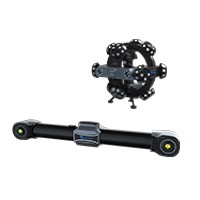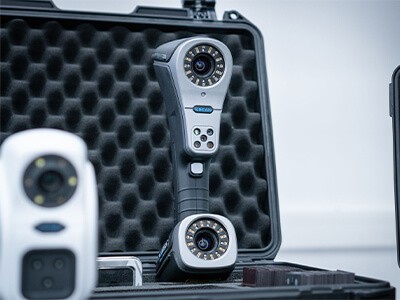Paint Protection Film to Build Automobile Data Center by 3D Scanning
Environment-friendly invisible car film, a common name of transparent paint protection film, is a thermoplastic urethane often self-healing film applied to painted surfaces of a new or used car to protect the paint from stone chips, bug splatters, and minor abrasions.
It can effectively resist natural oxidation caused by long-term weathering and even protect carboys against mild scratches and sand splashing.
Case Analysis
Recently, one of our customers in automobile industry, a BMW 3 series owner wanted to stick paint protection film for his car but couldn’t find any exclusively prototyped product in the market. That prompted him to make an exclusively prototyped invisible car body film on his own.
Paint protection film falls into two categories: cut by computers and cut manually. The differences between them are as follows: for computer-cutting films, the cutting process precedes sticking, with the cutting process performed in accordance with automotive prototype data and the installation process implemented with high accuracy; on the contrary, manual-cutting films are installed in a reversed order.
The biggest advantage of computer-cutting is its security. Comparatively, manual-cutting inevitably involves cutter operations on top of paintwork and part disassembly (e.g., logo, door handle). Any accidental shake of the hand may result in a scratch on paintwork. In comparison, computer-cutting does not have such a risk.
In this scenario, one could build a 3D scanner to create a precise 3D model of the vehicle’s surface. This model could then be used to cut the protective film to an exact fit, ensuring a seamless application and enhancing the effectiveness of the protection offered by the film.
In the meantime, computer-cut films provided as pre-cut products can significantly reduce the waste of raw materials and skill requirements on operators, thereby increasing work efficiency.
Despite the evident advantages of computer-cut films, they often entail extremely high requirements on automotive prototype data – production needs can only be met with the availability of large, constantly updated databases. Thus, not all invisible car bodies adopt a computer-cut film system. The car owner as mentioned earlier would have not had the idea of making his own paint protection film if he could find a computer-cut counterpart (direct pasting without the use of cutters) in the market.
Difficulties of Making Paint Protection Film
The typical process for making exclusively prototyped paint protection film is large as follows: 3D scanning the whole car, obtaining a 3D model → processing the 3D model, curved surface development, producing exclusive automotive prototype → cutting film → film sticking. Such a process imposes extremely high requirements on data accuracy for the paint protection film to be tightly fitted on the vehicle with clear edges, right sizes but without wrinkles. To that end, nothing is more suitable for this work than a high-precision handheld 3D scanner.
The major obstacles for obtaining automotive data are extremely large measuring area and numerous curved surfaces. A handheld 3D scanner has such advantages as ease of operation, non-contact scanning, high precision for image stitching, fast scanning speed, fine and complete 3D data, enabling the 3D scanner to adequately satisfy the needs of obtaining automotive body data.
SCANTECH 3D Solution
SCANTECH offers multiple series of products including KSCAN composite 3D scanner, AXE global 3D scanner and PRINCE handheld 3D scanner. All of them utilize markers to fulfill the high-precision positioning scan. Specifically, KSAN and AXE 3D scanners feature a large scanning area, super-fast scanning speed (about 30s to scan an automotive door) and a built-in photogrammetry system with a volumetric accuracy of 0.030 mm/m to effectively ensure the precision of the vehicle data.
With respect to the development of paint protection film, SCANTECH provides portable and tracking 3D solutions.
Method 1
PRINCE handheld 3D scanner has two scanning modes: red and blue laser scanning, combining flexibility and efficiency of handheld 3D scanners and the high detail capturing of structural 3D scanners with a resolution of 0.030 mm. Thus, PRINCE 3D scanner can perfectly satisfy the needs of obtaining 3D data of automotive car body.
PRINCE scanner can be used to obtain 3D data of vehicle body (by using magnetic markers that can be absorbed automatically onto car body); data of lamps, angles and grilles, should also be accurate and complete.


Method 2
TrackScan tracking 3D system adopts intelligent optical tracking measurement technology to fulfill ultra-high-precision 3D measurement without using markers, which can significantly improve work efficiency and reduce costs arising from manual power or materials.
Based on the requirements of different scan scenarios, the TrackScan 3D scanner can freely switch to multiple work modes. Multiple crossed blue laser lines facilitate ultrafast scanning with high efficiency and flexibility; parallel blue laser lines ensure high-precision scanning with extreme details; a single blue laser line is deployed to quickly obtain 3D data of deep holes and dead angles.
Paint protection film prototype drawing

For more cases related to the automobile industry:
Auto Parts Inspection: More Effective than Ever
Efficiency-improved 3D Scanning for Automotive Exhaust Systems
Large Automotive Mold Measuring Only by One 3D Scanner?
How 3D Scanning Optimizes the Design Process of Truck Grille














